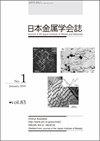Chlorine Leaching of Nickel and Cobalt Mixed Sulfide using Iron Chloride Solution
IF 0.4
4区 材料科学
Q4 METALLURGY & METALLURGICAL ENGINEERING
引用次数: 0
Abstract
The matte chlorine leach and electro ︲ winning ( MCLE ) process, developed by Sumitomo Metal Mining Co., Ltd. ( SMM ) is well known as a unique commercial nickel refining process with a high nickel recovery ratio. SMM has gradually increased the ratio of mixed sulfide ( MS: mixture of nickel and cobalt sulfides ) that can be used as a raw material in the MCLE process over the past decade. However, the reactivity of MS in chlorine leaching remains insufficient and further improvements are needed. We performed bench scale chlorine leaching tests with iron chloride, instead of the currently used copper chloride, as an oxi - dant medium for chlorine gas. However the reactivity of MS was not improved despite the higher oxidation ︲ reduction potential ( ORP ) of iron chloride than that of copper chloride. Though stability studies of iron chloride complexes based on an E ︲ pCl ( poten - tial, ︲ log a Cl ︲ ) diagram, the chlorine leaching potential that is suitable for copper chloride was found to be too low for iron chloride. Reactivity of MS was improved at a higher leaching potentials; however this did not represent a significant improvement over copper chloride based methods. We elucidated the reaction mechanism and showed that chlorine leaching with iron chloride is not suitable for industrial application to MS. [ doi:10 . 2320 / jinstmet.J2016065 ]用氯化铁溶液氯浸出镍钴混合硫化物
由住友金属矿业株式会社(SMM)开发的磨砂氯浸电︲浸出(MCLE)工艺是一种独特的商业镍精炼工艺,具有很高的镍回收率。在过去的十年中,SMM逐渐增加了混合硫化物(MS:镍和钴硫化物的混合物)在MCLE工艺中用作原料的比例。然而,MS在氯浸出中的反应性仍然不足,需要进一步改进。我们用氯化铁代替目前使用的氯化铜作为氯气的氧化介质,进行了实验规模的氯浸出试验。尽管氯化铁的氧化还原电位︲(ORP)高于氯化铜,但MS的反应活性并未得到改善。虽然基于E︲pCl(电位,︲log a Cl︲)图对氯化铁络合物的稳定性进行了研究,但发现适合氯化铜的氯浸出电位对于氯化铁来说太低了。在较高的浸出电位下,质谱的反应性得到改善;然而,这并不代表比基于氯化铜的方法有显著的改进。我们阐明了反应机理,并表明用氯化铁进行氯浸不适合用于ms的工业应用[doi:10]。2320 / jinstmet。J2016065]
本文章由计算机程序翻译,如有差异,请以英文原文为准。
求助全文
约1分钟内获得全文
求助全文
来源期刊

Journal of The Japan Institute of Metals
工程技术-冶金工程
CiteScore
0.70
自引率
0.00%
发文量
27
审稿时长
6-12 weeks
期刊介绍:
Information not localized
 求助内容:
求助内容: 应助结果提醒方式:
应助结果提醒方式:


